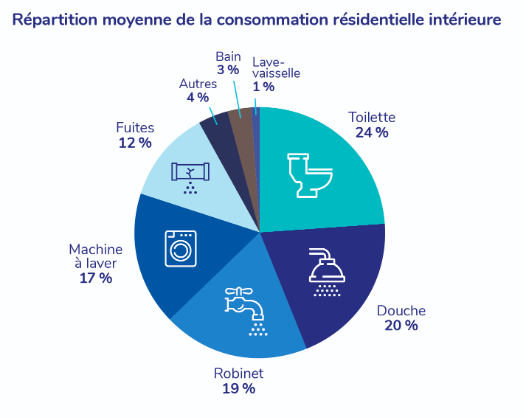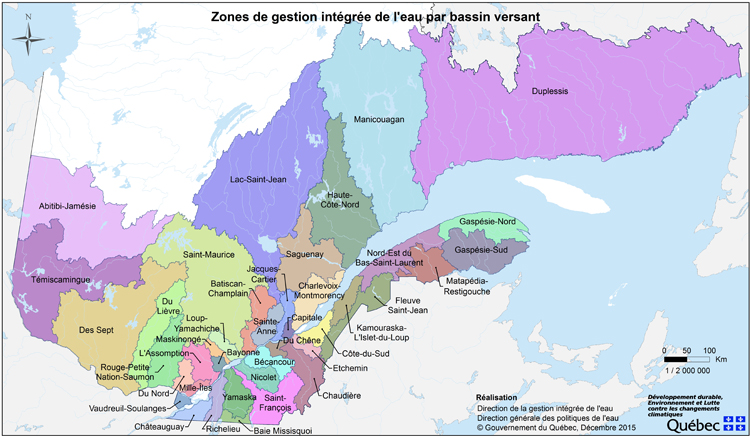Low water levels and hydrological droughts
The projected increase in hydrological drought and low water levels in Quebec due to climate change makes adaptation measures essential.
They are designed to protect water resources and ensure the resilience of the province’s population, ecosystems and economic activities.
Continuing efforts to raise awareness and transfer knowledge
The misconception that water is abundant in Quebec still persists, despite episodes of water scarcity in the province. We need to continue raising awareness in government and municipalities, and among economic players as well as the general public, so that they understand the issues associated with water scarcity in the context of climate change. This awareness-raising is essential to mobilize all the parties involved and prepare them to meet these challenges.
Reducing the distribution and consumption of drinking water
Since the launch of the first Quebec drinking water conservation strategy in 2013, Quebec has reduced its consumption by 26%, exceeding its target of 20%. Even so, there is still room for improvement, as Quebec’s consumption of drinking water remains higher than the Canadian average.
In 2018, Quebec residential consumption reached 268 litres per person per day (L/pers/d), 22% higher than the 2017 Canadian average (220 L/pers/d) and 46% higher than the 2017 Ontario average (184 L/pers/d). Quebec’s new drinking water conservation strategy for 2019-2025 aims to reduce the distribution of drinking water to below Canadian levels.
Effective management of water demand can help reduce pressure on water resources during periods of hydrological drought. This can include measures such as reducing leaks in water systems, raising public awareness of the importance of water conservation, promoting efficient water use practices, subsidies for the purchase of water-efficient equipment, installation of water meters and water pricing.
Tool | Tips and tricks for reducing residential water consumption

As part of the “Mon empreinte bleue” campaign, the Ministère des Affaires municipales et de l’Habitation is making various tips and tricks for reducing water consumption at home available to the general public.
Thanks to this research project, water supply managers in participating municipalities now have the tools they need to assess their vulnerability to climate change. The results of the project will help guide sustainable water resource management by taking climate change into account.
Water reservoirs
Using water conservation technologies such as reservoirs or dams is another potential adaptation measure. They can store water during periods of heavy rainfall and release it during times of drought, helping to mitigate the effects of low water levels. However, it’s important to assess the impact of these measures on the surrounding ecosystems and communities beforehand.
Bioretention basins in urban environments can also contribute to the storage of water resources. In certain contexts, this type of infrastructure can help recharge the groundwater, which is a clear advantage during low water periods.
The major project on Saint-Maurice Street in Trois-Rivières is a prime example. In addition to recharging and replenishing the water table, the project has improved the quality of runoff water thanks to increased vegetation in several sections of the street.
The QClim’Eau initiative is part of a long-standing collaboration between the MELCCFP and Ouranos to make advances on hydroclimatology issues in a coordinated way with cutting-edge expertise. Ouranos will help the ministry take climate change into account in regulatory work relating to the determination of flood zones and mobility. The project also aims to analyze requests for water withdrawal authorizations.
QClim’eau has two main objectives:
-
Quantify the impact of climate change on surface water and groundwater availability, water demand, flooding and watercourse mobility
-
Support all stakeholders in learning about this issue to encourage the adaptation of water and land management practices to the new realities of water resources in the context of climate change
Conserving and restoring wetlands
Wetlands help regulate river flows and improve water quality by filtering pollutants. Their preservation and restoration is essential to counter the negative effects of low water levels and hydrological droughts, in particular by promoting sustainable development in nearby urban areas.
Maintaining drinking water quality
Optimizing sanitation methods in water treatment plants is another adaptation measure to maintain water quality during low water periods and hydrological droughts. Refurbishing or modernizing these facilities would also increase their treatment capacity and their sustainability.
The city of Montréal plans to start ozonating water at the Jean R. Marcotte station in 2025, enabling it to eliminate various pollutants and contaminants such as viruses, bacteria and pharmaceutical products.
Land use planning
Sustainable land use planning is another key aspect of water management with regard to the preservation of the abundance and quality of water, access to water bodies and watercourses, and the reduction of water-related risks for communities.
Municipalities are on the front lines and can play a crucial role in preventing usage conflicts by adopting an integrated approach to land use planning that takes water management issues into account, particularly in the context of climate change.
Integrated water resource management
An integrated water resource management approach, which considers the social, economic and environmental aspects of water management, can help anticipate and respond to the impacts of low water periods and prevent or manage water use conflicts. This involves coordination and collaboration between the various parties involved in water management, such as governments and different water users.
Integrated water resource management in Quebec

In Quebec, integrated water management is organized by watershed. Each watershed is managed by one of 40 watershed organizations known as organismes de bassin versant or OBVs. The mandate of the OBV is to develop a water master plan whose objective is to carry out a diagnosis of the watershed and to define the issues, orientations and objectives to be achieved. The aim of the plan is to encourage concerted action and greater responsibility on the part of the various water stakeholders and the general public with regard to this shared resource.
Based on the objectives and issues identified in its water master plan, the OBV takes action by conducting public education and awareness-raising activities, undertaking projects to restore damaged aquatic ecosystems, working on stormwater management to minimize the risk of flooding, carrying out monitoring activities to assess water quality and the quantity available, and more.